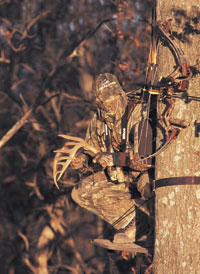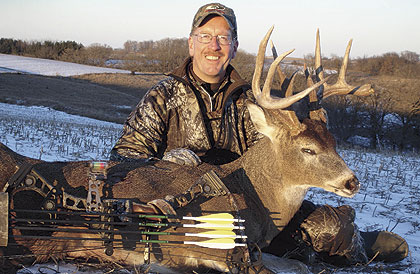November 04, 2010
By Scott Bestul
When it comes to calling and rattling, one fact is guaranteed -- they don't work if you don't do them.
By Scott Bestul

Advertisement
|
Advertisement
I was 15 minutes from eating my tag when a doe came bombing out of a plum thicket -- tail up, head out -- as if she had a coyote on her heels. With so little time left to fill my coveted Iowa deer tag, I prayed something else, something with big antlers, might be on her heels instead.
The doe reached a creek bank, skidded to a halt, and then trotted straight away from me, tail held high. Studying her through binoculars, I almost missed the buck. He followed the doe's path to the creek, but when he reached the bank he kept right on going, crossing the water in two bounds and bull-shouldering into the thick CRP on the opposite side. By the time I remembered my rattling antlers hanging on a peg at arm's reach, the buck was 400 yards away.
With only seconds to change the buck's course as he was about to disappear, no doubt forever, into a woodlot, I airmailed the first rattling sequence right into his zip code. As hard as I hit the horns, it's a good thing I had sawed the brow tines off or I would have driven one through the base of my thumb.
The instant the buck heard my "fight" he locked up, whirled, and stared in my direction. When he started trotting my way, I hung the horns and grabbed my bow. By the time I'd clipped my release onto the string, he'd jumped the creek and two fences, and when I shot him at 20 steps, the battler had covered more than 400 yards in less than a minute.
If you're guessing this was classic peak-rut rattling, guess again. The fact is, with only two days remaining in November, peak breeding across much of the Midwest was basically history.
Most hunters perceive post-rut whitetails as weary, eager to put the feedbag on, and not nearly as vulnerable to the scents, calls, and aggressive tactics that fooled them so readily a month before. That perception holds some truth, of course, but as the buck I tagged that night proves, it's not the whole truth.
Although the main event is over, mature post-rut bucks are still vulnerable to calling. These experienced breeders seem to sense that if they keep looking, they'll find one more doe willing to entertain them. Consequently, love-hungry older bucks often respond well to grunting and rattling.
Over the years I have upped my success by following three post-rut rules, and I think these rules will improve your success, too.
Rule#1: Believe
Plenty of folks know a lot more about rattling horns and grunt calls than I, but I do know this -- you will not call in a deer with these tools if you leave them in your vehicle. Please do not take that as sarcasm. This past winter I gave seminars at deer shows, and the most frequent question about rattling and calling was, "Do those really work?"
The short answer, of course, is, "Yes, rattling and calling do work." But the answer goes deeper than that. Many people seem to think that if animals don't respond immediately to their calling, they (the hunters) have made a massive communications blunder. They take it personally. During my early calling years, if bucks failed to respond to my first calling attempt with cheerful enthusiasm, I sheepishly slid my call into my pocket to avoid further embarrassment. If I could have apologized to the animals, I would have.

Fifteen minutes from eating my Iowa tag, I hit the rattling antlers hard. The results could not have been more pleasing. |
But after calling-in dozens of deer over the years, I've made a 180-degree switch. I now realize that bad calling is not the sole -- or even significant -- reason why deer fail to respond. A buck simply may not be in the mood, he may have a wimpy personality, he could be tired from chasing does all night, or he might have just got his tail kicked. Also, calling works better in certain areas than others -- herd densities, buck/doe ratios, and hunting pressure all have an effect.
Now these things never stop me from trying, and rather than getting down on my calling abilities, I blame the deer. "What's the problem?" I sneer. "Not in the mood for love today?" Or, "Hah! I knew these horns would scare off a wimp like you!" Remember, even at its best, calling is a low-odds endeavor.
Remember, also, it is a ZERO-ODDS endeavor if you never do it. Even if I've called for a week steady without a response, I still grunt, rattle, and bleat on virtually every setup. I just keep visualizing a lonely buck out there, and I'll be the companion he's desperately seeking.
Rule 2: Amp It Up
If you learned to hunt whitetails in the pre-video/TV age, I can almost guarantee that you have BATMAS Disease. Never heard of that? Well, BATMAS is short for Bestul's Afraid-To-Make-A-Sound disease. Sufferers learned deer hunting from dads, grandpas, and uncles who likened any noise in the deer woods to passing gas in church -- taboo! So deeply was that lesson burned into my psyche that, for years, any sound I made louder than a leaf rustle had me looking over my shoulder, expecting my dad to be glaring at me. For those of us raised with this mindset, making noise of any kind -- intentionally -- can cause mental anguish of the highest order.
Well, fellow sufferers of BATMAS, I have bad news for you. Not only should you make noise, you should make a lot of it. Why? Because under most conditions, bucks respond more favorably to loud calling and rattling than to soft. During three recent hunting seasons I kept notes on my calling success, and nearly 90 percent of the time when bucks responded favorably, I was calling loudly and frequently.
Why is volume important? My best theory consists of two tenets: 1) Deer do not hear as well as we think they do; 2) We are never calling or rattling as loudly as we think we are. In regard to No. 1, Dr. Karl Miller's research at the University of Georgia suggests that, while deer are masters at pinpointing sound, their ears are not vastly more sensitive than those of human beings. In addition, many things can interfere with a buck's ability to hear a call -- his own breathing (while running), wind, crunching leaves, snapping sticks, his chewing an acorn, other deer making noise.
As for No. 2, I proved this to myself in a simple test. I took my eight-year-old twins outside, gave each a little flag, and had them face away from me. Every time they heard me blow a grunt call, they were to raise their flags. I tested several grunt calls, and, as I blew with gusto, the kids could hear only a couple of models from as far as 55 yards. And
this was on a calm day on open ground with no interference from trees or brush.
The message? You may think you're really hammering on a grunt call, but you may not be. If you think of all the things that could affect a buck's ability to hear you -- dense foliage, crunchy leaves, his own breathing -- you'll recognize why calling loud is usually the best approach.
Rule 3: Learn to Read Body Language
In my opinion, to call in more deer, you must judge their mood and receptivity. Since you cannot read a whitetail's mind, you have to rely on the next best thing -- body language -- to interpret a deer's mood. I know, I know. This sounds like stuff wives and girlfriends would say -- "I shouldn't have to tell you how I feel. You should just KNOW!" Trust me, bucks are way easier to read than babes, even for a dolt like me.
The first telltale sign is some indication that a deer has heard the call. A lot of guys goof up here because they think if a buck doesn't trot right in, the calling isn't working, the deer is spooked, or, well, look to Rule #1 for other possibilities. Truth is, if a buck hears your call, he almost always will give some sign, ranging from subtle -- the twitch of an ear, a pause in stride -- to dramatic -- snapping up of the head, bristling back hairs, a hard stare. If you don't see some acknowledgement, amp things up until you know you have his attention.
Once you know a buck has heard you, watch closely to see how each call you make affects him. If he looks your way, eyes searching for another deer, he's interested. Ears up may indicate curiosity; ears laid back signify aggression. Tail, back hair, nape hair, even stance, can all hint at a buck's mood.
Space restrictions don't allow a full discussion on body language and the appropriate calling response, but I can offer a couple of my personal guidelines. First, I don't grunt or rattle at a deer when he's looking my way, especially in open forest. Whitetails can pinpoint sound sources, and an alert buck will instantly spot any movement at the source of calling.
Second, if a buck seems at all reluctant to come -- for whatever reason -- I will quit calling unless I'm convinced he can't bust me if he circles. Invariably, a nonaggressive buck will swing downwind to scent-check the source of calling before committing, and educating a deer I want to hunt later is not smart hunting. I'll save him for another day.
Wrap Up
One advantage of calling during the post-rut is that bucks often behave as my Iowa star did that afternoon. With the rut winding down, bucks haven't heard or seen aggressive talk or behavior for a while, and when they do tune into it, they often respond dramatically.
The take-home lesson? Have faith in your hunt and your calling. As my Iowa buck proved, it takes only one buck in the right mood -- and 15 minutes left in the hunt -- to make your calling efforts pay off.
The author is an outdoor writer/photographer and friend of this magazine. He makes his home in Lewistown, Minnesota.
